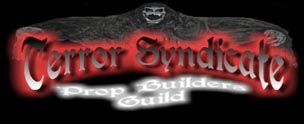
Wicked Beernut Home - Halloween Home - Monster Mud Props
The Undertaker
Most of the pictures on this web page are thumbnails. Each thumbnail is ¼ size and ¼ quality of the full image, approximately 3K - 10K bytes. Each thumbnail is a hyperlink to a full image that is approximately 30K - 100K bytes.
Winner of the inaugural Terror Syndicate Prop Builders Guild Award, September 2001!
Main Construction
The Undertaker was inspired by (shamelessly stolen from) Steve Hickman's Terror Syndicate. The Undertaker is a cross between Steve's Acolyte and Watcher. The construction of these two props is detailed in Steve's Home Haunter's Prop Building Handbook #2. I highly recommend all of Steve's handbooks.
The Head
The mask is titled 'Dead Guy' and was designed by Erich Lubatti at Lubatti Illusions. I purchased the mask from the Halloween Outlet for $59. The mask came with rather cheesy, wispy hair that I pulled off.
I bought a pair of $6.95 brown, full, round, acrylic eyes from the Monster Makers.
I pulled the mask over a male wig head and traced the holes corresponding to the eyes with a Sharpie marker. I removed the mask from the wig head and began to gouge out the eye sockets using a Dremel until they would accept the acrylic eyes.
I purchased a pair of white LEDs (Catalog #276-320) from Radio Shack for $4.99 each. I soldered a pair of 12" color-coded wires to each LED. The color-coding corresponds to the polarity of the LEDs.
The T 13/4 LEDs fit perfectly into the stem of the acrylic eyes. I opted to epoxy the LEDs to the acrylic eyes. The two halves of the acrylic eyes twist apart. I epoxied the two halves of the acrylic eyes together.
I used a long drill bit to drill a hole from the back of each eye socket through to the back of the wig head. I fed the wires from each LED through their respective hole. I soldered the positive wire of one LED to the negative wire of the other LED. I used Doug Ferguson's equation from Phantasmechanics to calculate the resistance of the ballast resistor.
Rballast = (Vpower supply - VLEDs) / 0 .015 = (9 - 3.6 - 3.6) / 0.015 = 120 W
I soldered the remaining positive and negative wire to an AC-to-DC 9-volt transformer with the ballast resistor between the positive wire of the LED and the positive wire of the transformer.
The Hands
I used a pair of Steve's Gravestalker prop hands.
I started by numbering the phalanges of each hand (all of the phalanges of a given finger or thumb had the same number). I then used a hacksaw blade to cut off each phalange at each knuckle. I then cut a 'wedge' from the end of each phalange such that when the phalanges were reassembled the resulting hand would be in the form of a fist. I dry-fit the phalanges of each finger and then glued them together with epoxy glue. You'll notice that the fist of the hand that holds the lantern is a little tighter than the hand that holds the shovel.
I used a 1" spade bit to drill a hole into the wrist of each prop hand to accept a 1" wood dowel. In the case of the hand that holds the lantern, I drilled the hole almost to the fingers. In this case, the wood dowel accepts a hook to hold the lantern. You need to be extremely careful not to break through the palm or the back of the hand. I slid a length of black drip tubing over the hook to help hide it. The hook can be removed while the hand is being painted.
I used a foam brush to blot each hand with mask latex from the Monster Makers.
Once the mask latex was dry, I airbrushed each hand with medium flesh colored mask paint from the Monster Makers. I highlighted the hands with a touch of gray (a custom blend of light flesh and black mask paint) in an attempt to match the Dead Guy mask.
The Lantern
I bought the kerosene lantern from Camping-R-Us.com for $6.99.
I started by removing the glass lens from the lantern.
The vertical supports of the lantern are actually hollow. I drilled a small hole in one of the supports just below where the wire hanger is attached. I carefully fed electrical wire through this hole, through the vertical support and into the base. I wired the lantern with a candelabra base.
I taped a small plastic sandwich bag over the lens of the lantern. I lightly sprayed the inside of the lens with flat black spray paint in order to create the illusion of soot. I may have overdone it a bit, but the soot helps to hide the cheesy effect of the hardware store flicker bulb.
I used epoxy glue to secure the electrical wire to the wire hanger. I used cable ties to hold the electrical wire in place while the glue dried.
I lightly dusted the entire lantern with flat black spray paint in order to age it a bit and then replaced the glass lens.
The kerosene lantern plugs into a socket that is secured to the underside of the right forearm. An electrical wire runs from the socket to a junction box that is mounted on top of the shoulder plate. The electrical wire is stapled along the length of the arm.
The LED transformer plugs into the junction box. An electrical wire runs from the junction box along one of the 60" 2x3s which form the main supports for the body. I stapled the electrical cord along the length of the 2x3s.